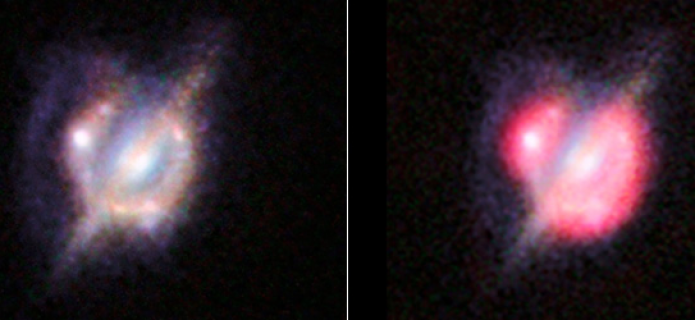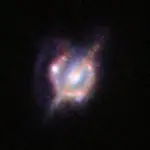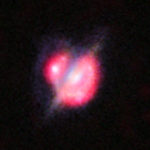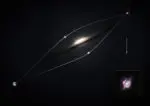ALMA applies methods of Sherlock Holmes to get the best view yet of merging galaxies in distant Universe
Using the Atacama Large Millimeter/submillimeter Array (ALMA), and many other telescopes on the ground and in space, an international team of astronomers has obtained the best view yet of a collision that took place between two galaxies when the Universe was only half its current age. They enlisted the help of a galaxy-sized magnifying glass to reveal otherwise invisible detail. These new studies of the galaxy H-ATLAS J142935.3-002836 have shown that this complex and distant object looks like the well-known local galaxy collision, the Antennae Galaxies.
The famous fictional detective Sherlock Holmes used a magnifying lens to reveal barely visible but important evidence. Astronomers are now combining the power of many telescopes on Earth and in space [1] with a vastly larger form of cosmic lens to study a case of vigorous star formation in the early Universe.

Fig. 1 y 2: Merging galaxies in the distant Universe through a gravitational magnifying glass. This picture combines the views from the NASA/ESA Hubble Space Telescope and the Keck-II telescope on Hawaii (using adaptive optics). Credit: ESO/NASA/ESA/W. M. Keck Observatory
"While astronomers are often limited by the power of their telescopes, in some cases our ability to see detail is hugely boosted by natural lenses, created by the Universe," explains lead author Hugo Messias of the Universidad de Concepción (Chile) and the Centro de Astronomía e Astrofísica da Universidade de Lisboa (Portugal). "Einstein predicted in his theory of general relativity that, given enough mass, light does not travel in a straight line but will be bent in a similar way to light refracted by a normal lens."
These cosmic lenses are created by massive structures like galaxies and galaxy clusters, which deflect the light from objects behind them due to their strong gravity - an effect, called gravitational lensing. The magnifying properties of this effect allow astronomers to study objects which would not be visible otherwise and to directly compare local galaxies with much more remote ones, seen when the Universe was significantly younger.
But for these gravitational lenses to work, the lensing galaxy, and the one far behind it, need to be very precisely aligned.

Fig. 3: This diagram shows how the effect of gravitational lensing around a normal galaxy focuses the light coming from a very distant star-forming galaxy merger to created a distorted, but brighter view. Credit: ESO/M. Kornmesser
"These chance alignments are quite rare and tend to be hard to identify," adds Hugo Messias, "but, recent studies have shown that by observing at far-infrared and millimeter wavelengths we can find these cases much more efficiently."
H-ATLAS J142935.3-002836 (or just H1429-0028 for short) is one of these sources and was found in the Herschel Astrophysical Terahertz Large Area Survey (H-ATLAS). Although very faint in visible light pictures, it is among the brightest gravitationally lensed objects in the far-infrared regime found so far, even though we are seeing it at a time when the Universe was just half its current age.
Probing this object was at the limit of what is possible, so the international team of astronomers started an extensive follow-up campaign using the most powerful telescopes - both on the ground as well as in space - including the NASA/ESA Hubble Space Telescope, ALMA, the Keck Observatory, the Karl Jansky Very Large Array (JVLA), and others. The different telescopes provided different views, which could be combined to get the best insight yet into the nature of this unusual object.
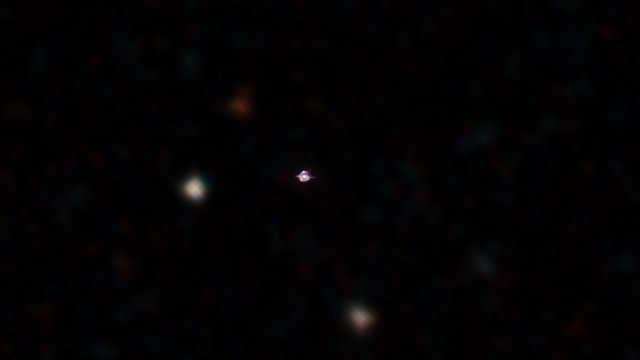
Fig. 4: This video takes the viewer deep into an apparently sparsely occupied region of the constellation of Virgo (The Virgin). Here at the center, looking like many other faint spots, is a remarkable object, a gravitationally lensed view of a distant galaxy merger. Credit: ESO/Digitized Sky Survey 2. Music: movetwo
The Hubble and Keck images revealed a detailed gravitationally-induced ring of light around the foreground galaxy. These high-resolution images also showed that the lensing galaxy is an edge-on disc galaxy - similar to our galaxy, the Milky Way - which obscures parts of the background light due to the large dust clouds it contains.
But this obscuration is not a problem for ALMA and the JVLA, since these two facilities observe the sky at longer wavelengths, which are unaffected by dust. Using the combined data the team discovered that the background system was actually an ongoing collision between two galaxies. From this point on, ALMA and the JVLA started to play a key role in further characterizing this object.
In particular, ALMA traced carbon monoxide, which allows detailed studies of star formation mechanisms in galaxies. The ALMA observations also allowed the motion of the material in the more distant object to be measured. This was essential to show that the lensed object is indeed an ongoing galactic collision forming hundreds of new stars each year, and that one of the colliding galaxies still shows signs of rotation; an indication that it was a disc galaxy just before this encounter.

Fig. 5: This artist's impression shows how the effect of gravitational lensing by an intervening galaxy magnifies, brightens and distorts the appearance of a remote merging galaxy far behind it. The viewpoint of the observer moves sideways so that that the distant galaxy merger appears first to one side, where it is faint, and then appears right behind the foreground object and is dramatically magnified and its total apparent brightness increases. Credit: ESO/M. Kornmesser
The system of these two colliding galaxies resembles an object that is much closer to us: the Antennae Galaxies. This is a spectacular collision between two galaxies, which are believed to have had a disc structure in the past. While the Antennae system is forming stars at a rate of only a few tens of the mass of our Sun each year, H1429-0028 turns more than 400 times the mass of the Sun of gas into new stars each year.
Rob Ivison, ESO’s Director of Science and a co-author of the new study, concludes: "ALMA enabled us to solve this conundrum because it gives us information about the velocity of the gas in the galaxies, which makes it possible to disentangle the various components, revealing the classic signature of a galaxy merger. This beautiful study catches a galaxy merger red handed as it triggers an extreme starburst."
Notes
[1] Among the armada of instruments that were used to provide evidence to help unravel the mysteries of this case were ALMA, APEX, VIST, the NASA/ESA Hubble Space Telescope, the Gemini South telescope, the Keck-II telescope, the NASA Spitzer Space Telescope, the Jansky Very Large Array, CARMA, IRAM and SDSS and WISE.
More Information
The Atacama Large Millimeter/submillimeter Array (ALMA), an international astronomy facility, is a partnership of the European Organisation for Astronomical Research in the Southern Hemisphere (ESO), the U.S. National Science Foundation (NSF) and the National Institutes of Natural Sciences (NINS) of Japan in cooperation with the Republic of Chile. ALMA is funded by ESO on behalf of its Member States, by NSF in cooperation with the National Research Council of Canada (NRC) and the Ministry of Science and Technology (MOST) in Taiwan and by NINS in cooperation with the Academia Sinica (AS) in Taiwan and the Korea Astronomy and Space Science Institute (KASI).
ALMA construction and operations are led by ESO on behalf of its Member States; by the National Radio Astronomy Observatory (NRAO), managed by Associated Universities, Inc. (AUI), on behalf of North America; and by the National Astronomical Observatory of Japan (NAOJ) on behalf of East Asia. The Joint ALMA Observatory (JAO) provides the unified leadership and management of the construction, commissioning and operation of ALMA.
This research was presented in a paper entitled “Herschel-ATLAS and ALMA HATLAS J142935.3-002836, a lensed major merger at redshift 1.027”, by Hugo Messias et al., to appear online on 26 August 2014 in the journal Astronomy & Astrophysics.
The team is composed of Hugo Messias (Universidad de Concepción, Chile; Centro de Astronomía e Astrofísica da Universidade de Lisboa, Portugal), Simon Dye (School of Physics and Astronomy, University of Nottingham, UK), Neil Nagar (Universidad de Concepción, Chile), Gustavo Orellana (Universidad de Concepción, Chile), R. Shane Bussmann (Harvard-Smithsonian Center for Astrophysics, USA), Jae Calanog (Department of Physics & Astronomy, University of California, USA), Helmut Dannerbauer (Universität Wien, Institut für Astrophysik, Austria), Hai Fu (Astronomy Department, California Institute of Technology, USA), Edo Ibar (Departamento de Astronomía y Astrofísica, Pontificia Universidad Católica de Chile, Chile), Andrew Inohara (Department of Physics & Astronomy, University of California, USA), R. J. Ivison (Institute for Astronomy, University of Edinburgh, Royal Observatory, UK; ESO, Garching, Germany), Mattia Negrello (INAF, Osservatorio Astronomico di Padova, Italy), Dominik A. Riechers (Astronomy Department, California Institute of Technology, USA; Department of Astronomy, Cornell University, USA), Yun-Kyeong Sheen (Universidad de Concepción, Barrio Universitario, Chile), Simon Amber (The Open University, Milton Keynes, UK), Mark Birkinshaw (H. H. Wills Physics Laboratory, University of Bristol, UK; Harvard-Smithsonian Center for Astrophysics, USA), Nathan Bourne (School of Physics and Astronomy, University of Nottingham, UK), Dave L. Clements (Astrophysics Group, Imperial College London, UK), Asantha Cooray (Department of Physics & Astronomy, University of California, USA; Astronomy Department, California Institute of Technology, USA), Gianfranco De Zotti (INAF, Osservatorio Astronomico di Padova, Italy), Ricardo Demarco (Universidad de Concepción, Barrio Universitario, Chile), Loretta Dunne (Department of Physics and Astronomy, University of Canterbury, New Zealand; Institute for Astronomy, University of Edinburgh, Royal Observatory, UK), Stephen Eales (School of Physics and Astronomy, Cardiff University,UK), Simone Fleuren (School of Mathematical Sciences, University of London, UK), Roxana E. Lupu (Department of Physics and Astronomy, University of Pennsylvania, USA), Steve J. Maddox (Department of Physics and Astronomy, University of Canterbury, New Zealand; Institute for Astronomy, University of Edinburgh, Royal Observatory, UK), Michał J. Michałowski (Institute for Astronomy, University of Edinburgh, Royal Observatory, UK), Alain Omont (Institut d’Astrophysique de Paris, UPMC Univ. Paris, France), Kate Rowlands (School of Physics & Astronomy, University of St Andrews, UK), Dan Smith (Center for Astrophysics Research, Science & Technology Research Institute, University of Hertfordshire, UK), Matt Smith (School of Physics and Astronomy, Cardiff University,UK) and Elisabetta Valiante (School of Physics and Astronomy, Cardiff University, UK).
Contact:
Hugo Messias
Universidad de Concepción, Chile /
Centro de Astronomia e Astrofísica,
Universidade de Lisboa, Portugal
Tel: +351 21 361 67 47/30
Email: [email protected]
Valeria Foncea
Education and Public Outreach Officer
Joint ALMA Observatory
Santiago, Chile
Tel: +56 2 467 6258
Cell: +56 9 75871963
Email: [email protected]
Richard Hook
Public Information Officer, ESO
Garching bei München, Germany
Tel: +49 89 3200 6655
Cell: +49 151 1537 3591
Email: [email protected]
Charles E. Blue
Public Information Officer
National Radio Astronomy Observatory
Charlottesville, Virginia, USA
Tel: +1 434 296 0314
Cell: +1 434.242.9559
E-mail: [email protected]
Masaaki Hiramatsu
Education and Public Outreach Officer, NAOJ Chile
Observatory Tokyo, Japan
Tel: +81 422 34 3630
E-mail: [email protected]
